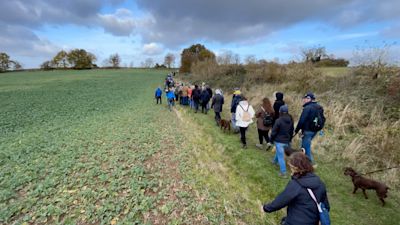Community comes together for countryside walk in fight against huge solar farm

Video report by Emma Wilkinson.
More than two hundred residents in North Nottinghamshire have joined a community walk across the countryside as they fight proposals to build a huge solar power site there.
Around 600 acres of land between the conservation villages of Clayworth and Gringley-on-the-Hill have been proposed as a site for ground-mounted solar panels that would connect to the grid via an underground cable to West Burton power station.
The land is one of four locations around the Lincolnshire/Nottinghamshire border that form part of Island Green Power's West Burton Solar Project. At the same time, the company is developing plans for a similar project connecting three locations into the now decommissioned Cottam power station.
Island Green Power claims collectively those projects could provide enough clean energy to power more than 320,000 thousand homes.
Hundreds of people around Gringley-on-the Hill and Clayworth have joined a No Solar Desert campaign to try and stop the proposals moving forward.
One of the organisers, Joanna Favill, said: "This is completely the wrong place for this. For a start, this land is already working for the UK population providing food. It's not a brownfield site, it's not a former landfill, it's not a quarry. There are far better sites for this and this is also a huge area of different habitats for a massive range of wildlife."
Local resident Pat Mee, who runs a wedding venue overlooking the land said it would put a stop to her business.
"I couldn't sell a beautiful view for someone's big day. It would be a solar desert of glass and metal. We live in the countryside, we know how important it is to be more green, but we have to pick the right places for these projects and this just isn't it."
The residents were joined on the community walk by their local MP, Brendan Clarke-Smith, and the Leader of Bassetlaw District Council.
Councillor Simon Greaves believes the site between Clayworth and Gringley is only being considered because of the willingness of the distant landowner, The Henry Smith Charity:"I believe solar power is an important part of our future. But this particular site has only been chosen because there is a willing landowner to do a deal with. According to Island Green Power's own criteria, this site would not be appropriate so money is driving this, not carbon reduction."
In a statement the Henry Smith Charity said: "The Charity’s land will provide the capacity to supply power to over 50,000 homes. The project also includes a biodiversity plan, landscape planting, the creation of a community fund and clear re-instatement provisions...
"As with all its decisions, the Charity carefully considered its duties and responsibilities, which are primarily to the Charity’s mission and beneficiaries. It was concluded that entering into the agreement with IGP would potentially enable the Charity to generate additional funds and so further its charitable objectives."Island Green Power said the decommissioning of the coal-powered West Burton and Cottam power stations present the opportunity – and the need – to repower the region with clean, green energy, while utilising existing grid infrastructure.
It added: "While the project’s importance is clear, we do of course recognise the need to deliver it sensitively with respect to the local environment [...] Our team has undertaken an extensive process of site selection to identify appropriate areas of land, considering a range of environmental factors."Dr Alastair Buckley from The University of Sheffield specialises in solar power research and says with solar power forming a significant part of our energy future, we are likely to see more tension around land use.
"In order to reach the scenarios necessary for a net-zero future we need between 20 and 40 similar sized solar projects in the UK. So there is a conversation about national benefit versus the local needs of people who live around proposed sites."
"Rooftops and brownfield sites have a role to play for solar power, but they don't provide the scale necessary and often are not cost effective enough for developers. Globally, solar will become the cheapest form of electricity generation just because of the way it's structured in terms of supply chains and the UK will take advantage of that."
The Island Green Power proposals are in their early stages, with a public consultation now running for six weeks until 15 December.